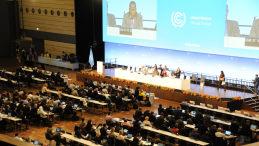National Adaptation Plans (NAPs) are central to a country’s strategy for building climate resilience. They provide a structured process for assessing climate risks, identifying adaptation needs and integrating solutions into national development frameworks. Sixty-three countries submitted their National Adaptation Plans so far. NAPs cannot only be planning paper; they need to become actionable strategies that build long-term resilience. This is also one of the main messages from the 2025 Bonn Climate Change Conference, where the urgency of shifting NAPs from planning to implementation was a central theme. Discussions also underscore persistent challenges: limited access to adaptation finance and insufficient technical capacity, particularly in developing countries. The discussion will continue at the NAP Expo 2025, where countries will exchange experiences and explore ways to advance NAP.
Why climate and disaster risk finance is key to bridging NAP implementation gaps
Despite growing needs, adaptation strategies and investments remain limited. Many countries also lack a structured approach to identify and secure financing for adaptation or to design bankable projects aligned with climate risk data. The disconnect between risk assessments and financial planning, as well as limited engagement from finance ministries and the private sector, are obstacles to implementing adaptation strategies .
In this context, climate and disaster risk finance and insurance (CDRFI) offers a valuable pathway forward. CDRFI refers to climate risk financing instruments – such as insurance schemes, contingency funds and catastrophe bonds – that help governments and communities manage the financial impact of climate-related hazards. These tools can offer rapid, predictable financial support for emergency response and recovery, reduce fiscal pressure and improve economic stability. Importantly, CDRFI fosters collaboration between the public and private sectors and strengthens risk-informed planning by incentivizing better data and risk analytics. When aligned with national climate policies, CDRFI instruments also protect adaptation investments and enhance resilience in vulnerable sectors. Given the NAPs’ central role in adaptation planning, integrating CDRFI into these frameworks is not just beneficial; it’s strategic.
A new practical tool supporting action
Although CDRFI has significant benefits, many countries face practical barriers in integrating it into their NAPs. These include a lack of clarity on how to start, which instruments to prioritize and how to align CDRFI with national development and climate objectives.
To help navigate these challenges, a new set of Supplementary Guidelines on Integrating Disaster Risk Finance into National Adaptation Plans was developed by UNDP, UNU-EHS and the Munich Climate Insurance Initiative. While not prescriptive, the guidelines offer a flexible framework that countries can adapt to their specific contexts.
There are several key actions countries may consider at different stages of the NAP process to strengthen the integration of CDRFI.
In the early stages, countries should assess their institutional readiness. This includes reviewing legal mandates, identifying the roles of relevant agencies and conducting a stocktake of existing risk financing instruments. Understanding current gaps (in data, capacity or funding) can inform efforts to access readiness support, such as from the Green Climate Fund.
In the preparatory phase of NAP development, it is essential to strengthen climate risk assessments and improve the understanding of which risks can be managed, transferred or absorbed. Countries should also assess the economic implications of climate hazards, explore the cost-benefit of different adaptation strategies and begin developing investment cases that reflect both adaptation priorities and CDRFI options across key sectors.
To move into implementation, countries will need to translate their plans into concrete action. This requires identifying stakeholders across ministries and agencies, embedding CDRFI considerations into national and sectoral plans and preparing a pipeline of projects that align with funding opportunities. Mobilizing resources, both domestic and international, and engaging with private sector actors are critical to making progress at this stage.
Finally, monitoring and evaluation systems must be strengthened to assess how well CDRFI measures are functioning within the broader NAP framework. Developing relevant indicators, establishing feedback loops and fostering adaptive learning will be vital to ensure that CDRFI contributes meaningfully to long-term resilience outcomes.
Throughout these phases, countries should also seek to align their NAPs with Nationally Determined Contributions (NDCs), ensuring coherence across national climate policy frameworks and avoiding duplication of effort. Integrating CDRFI into NAPs is not only a technical exercise; it is a strategic move that can enhance the financial realism, credibility and impact of national adaptation plans, which can help to turn plans into reality.





